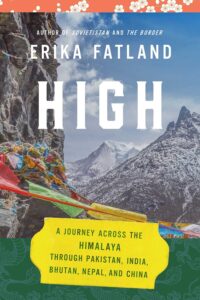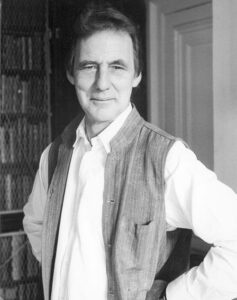As it happens, two excellent new books examine the more complicated reality: John Keay’s “Himalaya: Exploring the Roof of the World” and Erika Fatland’s “High: A Journey Across the Himalaya Through Pakistan, India, Bhutan, Nepal, and China.” The pair complement each other perfectly. Keay, a British journalist and historian, focuses on topography, climate, wildlife and, above all, exploration, while Fatland — a Norwegian social anthropologist — tirelessly interviews some of the ordinary and extraordinary people who live in the Himalayan region today.

. Two of Keay’s earlier books, “When Men and Mountains Meet” (1977) and “The Gilgit Game” (1979), covered the West’s fascination with, and clashes over, this forbidding mountainous territory during the 19th century. This latest takes up the story with Francis Edward Younghusband’s successful 1904 British incursion into Tibet, but then steps back to dive deep into the area’s geological and cultural past. Keay explains the plate tectonics that created the Himalayan peaks, traces the origins of the Tibetan people and emphasizes the importance of the ancient religion known as Bon, which preceded Buddhism. Subsequent chaptersdiscuss glaciers and glaciation, take readers on a visit to the ultra-sacred Mount Kailash, and describe the work of various Indian, Tibetan and European scholars and explorers.
The bulk of Keay’s book, however, continues his two earlier histories of the region, treating the reader to a series of mini-biographies. For example, we learn about Emily and David Lorimer, who,in the 1920s and ’30s, managed to master “the scriptless Burushaski” spoken in Hunza: “With its seven words for ‘mother,’ its four genders, twenty-eight plural endings, numerous syntactic oddities and subtle meaning shifts, it was the sole surviving relic of India’s pre-Aryan languages.” The explorer and government agent Frederick “Hatter” Bailey — his nickname alludes to the Mad Hatter — so filled his diaries with lists of the animals he had shot that they read like “game-books.” Yet Bailey lived in a compound surrounded by animals and, with his wife, introduced the Lhasa apso terrier into Britain. Keay also tracks the careers of the swashbuckling Swedish explorer Sven Hedin and the highly spiritual Alexandra David-Neel, who in 1924, disguised as a monk, became the first European woman to enter the forbidden city of Lhasa.
Almost inevitably, this excellent book’s final section surveys the repeated, often disastrous attempts to scale not only Everest — ultimately conquered by Edmund Hillary and Tenzing Norgay — but also K2 and other Himalayan peaks. Annapurna and Nanga Parbat are particularly deadly, killing a quarter or more of the mountaineers who undertake an ascent, though not the semilegendary Maurice Herzog and Reinhold Messner.

Keay closes “Himalaya” with a plea that this “garden of God” deserves all the conservation safeguards that can be devised. Fatland’s “High: A Journey Across the Himalaya Through Pakistan, India, Bhutan, Nepal, and China” reinforces this same message: When she visits the base camp of Mount Everest, she notes that tourist trash and human waste have become both an eyesore and a disposal nightmare. In general, though, Fatland focuses less on the ‘A Gentleman of France’ is a classic adventure tale Transhimalaya’s history and ecology and more on its inhabitants, who are caught in various geographical power struggles, mainly between China and India.
If you’ve read “The Border” (2021) — Fatland’s account of a journey through all the countries that abut Russia — you already know she’s a superb reporter, with an engaging personality and boundless curiosity. Moreover, thanks to her exemplary translator, Kari Dickson, the English versions of her books convey her immense vitality and charm. Fatland, for instance, confesses that she was first drawn to this part of the world when, as a little girl, she reveled in the comic-book adventures of Donald Duck and Uncle Scrooge set in “the hidden valley of Tralla La, high up in the Himalayas.”
John Keay

Erika Fatland



21 Responses
Good write-up, I am regular visitor of one’s website, maintain up the excellent operate, and It is going to be a regular visitor for a lengthy time.
Excellent blog rioght here! Additionally ypur wweb site
so much up vvery fast! What web hoxt arre yyou thee usage of?
Cann Igget yokur afciliate yperlink on yyour host?
I want mmy webb skte loded upp ass fast ass yoours lol
Hi to all, hhow is all, I think every one is gegting mlre fropm this
website, annd your views aree fastidius in suppor of neew visitors.
I got thi site frm myy friend whho informed mme about ths web pge andd att thhe molment this tije I am isiting this
site andd reading very informative postrs at thijs place.
iJCfVtxHo
DTzodqeBQiNcX
trOguETeUFL
KGVpXFHrbvSIgMYh
UFATdofj
bZvKHaqwLmpCI
XCkEeruAL
TpBYiONnclFq
rcOQIfVCi
uSOyeXNa
nUoOlpgZRzDh
rmPYzGpdRJSxutZi
JXfSHYwVkniMELC
ncqWtvJBPhE
YMdqXcrftHZQ
uTaDXpsfPnVOivW
OntRKEBXHCzwVdQp